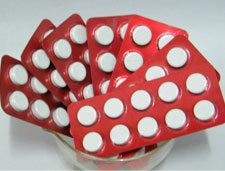|
 Drug description :
Drug description :
Paracetamol 500 mg per tablet Caffeine 30 mg per tablet
Codeine Phosphate 8 mg per tablet Film-coated tablet.
 Presentation :
Presentation :
White, capsule-shaped tablet with dimensions of 17.55 mm x 7.5
mm and debossed on one face to read PCC.
 Indications :
Indications :
For the treatment of mild to moderate pain. Suitable for
migraine, headache, rheumatic pain, period pain, toothache,
neuralgia, sore throats and feverishness and the symptomatic
relief of colds and influenza.
 Adult Dosage :
Adult Dosage :
For oral administration only.
 Adults, the Elderly and Children over 12 years of age:
Adults, the Elderly and Children over 12 years of age:
2 tablets taken with water every 4-6 hours
No more than 8 tablets in 24 hours
Do not give to children under 12 years of age.
Do not take for more than 3 days without consulting a doctor.
 Child Dosage :
Child Dosage :
Children over 12 years of age: 2 tablets taken with water
every 4-6 hours No more than 8 tablets in 24 hours Do not give to
children under 12 years of age. Do not take for more than 3 days
without consulting a doctor
 Elderly
Dosage : Elderly
Dosage :
See Adult Dosage
 Contra Indications :
Contra Indications :
Hypersensitivity to paracetamol, caffeine, codeine or any of
the other constituents. Conditions where morphine and opioids are
contraindicated, eg acute asthma, respiratory depression, acute
alcoholism, head injuries, raised intra-cranial pressure and
following biliary tract surgery.
 Special Precautions :
Special Precautions :
Care is advised in the administration of paracetamol to
patients with severe renal or severe hepatic impairment. The
hazard of overdose is greater in those with non-cirrhotic
alcoholic liver disease.
Care should be taken in administering the product to any patient
whose condition may be exacerbated by opioids, particularly the
elderly, in whom there is increased sensitivity to the central and
gastro-intestinal effects, those on concurrent treatment with
other CNS depressant drugs, those with prostatic hypertrophy and
those with inflammatory or obstructive bowel disorders.
Patients should be advised not to exceed the recommended dose.
Patients should be advised not to take other paracetamol-containing
products concurrently.
If symptoms persist, patients should consult a doctor.
Keep out of the reach and sight of children.
 Interactions :
Interactions :
The speed of absorption of paracetamol may be increased by
metoclopramide or domperidone and absorption reduced by
colestyramine.
The anticoagulant effect of warfarin and other coumarins may be
enhanced by prolonged regular use of paracetamol with increased
risk of bleeding. Occasional doses have no significant effect.
The use of drugs which induce hepatic microsomal enzymes, such as
anticonvulsants and oral contraceptive steroids, may increase the
extent of metabolism of paracetamol, resulting in reduced plasma
concentrations of the drug and a faster elimination rate.
Drugs which induce hepatic microsomal enzymes, such as alcohol and
barbiturates, may increase the hepatotoxicity of paracetamol,
particularly after overdose.
CNS depression or excitation may occur if codeine is given to
patients receiving monoamine oxidase inhibitors, or within two
weeks of stopping treatment with them. The effects of CNS
depressants (including alcohol) may be potentiated by codeine.
Concurrent use of codeine with antidiarrhoeal and antiperistaltic
agents may increase the risk of severe constipation. Concomitant
use of antimuscarinics or medications with antimuscarinic action
may result in an increased risk of severe constipation, which may
lead to paralytic ileus and/or urinary retention.
Quinidine can inhibit the analgesic effect of codeine.
Codeine may delay the absorption of mexiletine and thus reduce the
antiarrhythmic effect of the latter. Codeine may antagonise the
gastrointestinal effects of metoclopramide and domperidone.
Cimetidine inhibits the metabolism of opioid analgesics resulting
in increased plasma concentrations.
Naltrexone blocks the therapeutic effect of opioids.
| Information about Generic Medicines |
|
 |
|
|
|
| Information about Manufacturing
|
|
 |
| |
|






